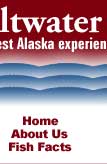King Salmon & Silver Salmon Fishing in Seward, Alaska
 |
 |
 |
 |
 |
 |
 |
 |
|
Year~Round - 12 Months a Year Feeder king salmon are prime quality salmon that feed in Alaskan waters and will not spawn until a later time. These fish provide an excellent eating experience with the highest Omega 3 content of any fish. The flesh of feeders can be red, white or a combination of the two. These fish run 15 to 60 pounds. As far as salmon go, these are the best! Dianne developed this fishery in Resurrection Bay. |
||||||
|
||||||
| Chum Salmon (keta) Arrive in our waters early in April and run through June. Keta have firm red flesh and a moderate oil content. They are prized for their eggs which make the best salmon caviar. Chum run 8 to 15 pounds. |
||||||
| Halibut / Rockfish We troll for these species and do not target them by the traditional methods. |
More about King Salmon (Chinook) King Salmon may spend one to eight years in the ocean (averaging from three to four years) before returning to their home rivers to spawn. The salmon also undergo radical morphological changes as they prepare for the spawning event ahead. All salmon lose the silvery blue they had as ocean fish, and their color darkens, sometimes with a radical change in hue. Salmon are sexually dimorphic, and the male salmon develop canine-like teeth and their jaws develop a pronounced curve or hook, called a “kype”. Studies have shown that larger and more dominant male salmon have a reproductive advantage as female Chinook are often more aggressive toward smaller males. Chinook spawn in larger and deeper waters than other salmon species and can be found on the spawning redds (nests) from September to December. The female salmon may lay her eggs in four to five nesting pockets within a redd. After laying eggs, females guard the redd from four to 25 days before dying, while males seek additional mates. It has been observed that females are typically 98% successful at guarding their redds. Chinook eggs hatch, 90 to 150 days after deposition, depending upon water temperature. Egg deposits are timed to ensure the young salmon fry emerge during an appropriate season for survival and growth. Fry and parr (young fish) usually stay in fresh water 12 to 18 months before traveling downstream to estuaries where they remain as smolts for several months. Some Chinooks return to the fresh water one or two years earlier than their counterparts, and are referred to as "jack" salmon. "Jack" salmon are typically less than 24 inches (61 cm) long, but are sexually mature and return at an earlier age. The Chinook salmon is spiritually and culturally prized among certain Native American tribes. Many celebrate the first spring Chinook caught each year with "first-salmon ceremonies". While salmon fishing is still important economically for many tribal communities, the Chinook harvest is typically the most valuable. Chinook salmon were described and enthusiastically eaten by the Lewis and Clark Expedition. Lewis wrote that, when fresh, they tasted better than any other fish he had ever eaten. They did not particularly like dried or "pounded" salmon. Lewis and Clark knew about Pacific salmon, but had never seen one. The Western world had known about Pacific salmon since the late 18th century. Maritime fur traders and explorers, such as George Vancouver, frequently acquired salmon by trade with the indigenous people of the Northwest coast. Lewis and Clark first encountered Chinook salmon as a gift from Chief Cameahwait, on August 13, 1805, near Lemhi Pass. Tasting it convinced Lewis they had crossed the continental divide. Known as the "king salmon" in Alaska for its large size and flavorful flesh, the Chinook is the state fish of Alaska and of Oregon. |
Home
| About Us |
Fish Facts | Gallery |
Recipes | Contact Us
Our Commitment to Quality
|
Alaska Saltwater
Charters |
King Salmon fishing charters from Seward
Alaska
Hosted by Net Alaska Web Services